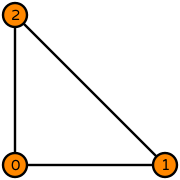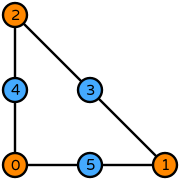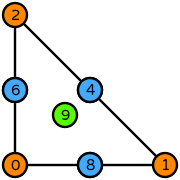Bernstein
Click here to read what the information on this page means.
| Alternative names | Bernstein–Bézier |
| Degrees | \(0\leqslant k\) where \(k\) is the Polynomial superdegree |
| Polynomial subdegree | \(k\) |
| Polynomial superdegree | \(k\) |
| Reference elements | interval, triangle, tetrahedron |
| Polynomial set | \(\mathcal{P}_{k}\) ↓ Show polynomial set definitions ↓ |
| DOFs | On each vertex: point evaluations On each edge: evaluation of Bernstein coefficients On each face: evaluation of Bernstein coefficients On each volume: evaluation of Bernstein coefficients |
| Number of DOFs | interval: \(k+1\) (A000027) triangle: \((k+1)(k+2)/2\) (A000217) tetrahedron: \((k+1)(k+2)(k+3)/6\) (A000292) |
| Mapping | identity |
| continuity | Function values are continuous. |
| Categories | Scalar-valued elements |
Implementations
This element is implemented in FIAT , Symfem , and (legacy) UFL.↓ Show implementation detail ↓Examples
| interval degree 1 |  (click to view basis functions) |
| interval degree 2 |  (click to view basis functions) |
| interval degree 3 |  (click to view basis functions) |
| triangle degree 1 |  (click to view basis functions) |
| triangle degree 2 |  (click to view basis functions) |
| triangle degree 3 |  (click to view basis functions) |
References
- Ainsworth, Mark, Andriamaro, Gaelle, and Davydov, Oleg. Bernstein–Bézier finite elements of arbitrary order and optimal assembly procedures, SIAM Journal on Scientific Computing 33(6), 3087–3109, 2011. [DOI: 10.1137/11082539X] [BibTeX]
- Kirby, Robert C. Fast simplicial finite element algorithms using Bernstein polynomials, Numerische Mathematik 117(4), 631–652, 2011. [DOI: 10.1007/s00211-010-0327-2] [BibTeX]
DefElement stats
| Element added | 20 February 2021 |
| Element last updated | 27 September 2024 |